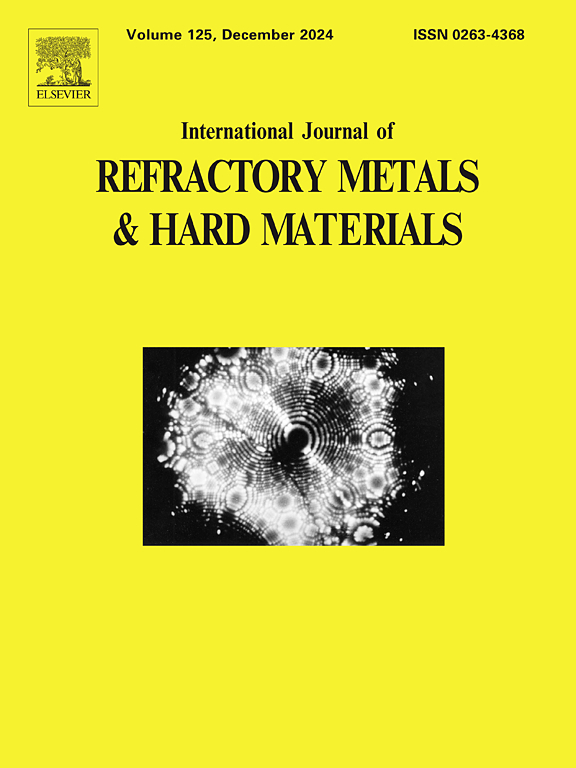采用TIG PBF-AAM方法制备具有可变B4C梯度策略的B4C- aisi 434l钢功能梯度薄壁结构
IF 4.2
2区 材料科学
Q2 MATERIALS SCIENCE, MULTIDISCIPLINARY
International Journal of Refractory Metals & Hard Materials
Pub Date : 2025-04-28
DOI:10.1016/j.ijrmhm.2025.107210
引用次数: 0
摘要
采用钨惰性气体辅助粉末床熔合电弧增材制造(TIG PBF-AAM)方法,采用三种不同的B4C梯度策略(平滑、适度和陡峭)制备了B4C- aisi 434 L SS复合材料的功能梯度薄壁结构。对于所有不同的策略,在构建方向上,可以观察到晶粒结构,相组成,显微硬度以及耐磨性和抗划伤性的实质性变化。FG结构的SEM和XRD分析表明,B4C的稀释和硼化铁(Fe2B, FeB)相的形成在很大程度上受特定区域B4C比例的影响。随着B4C含量向建筑方向增加,未反应B4C相的比例增加,梯度结构的硬度和耐磨性显著提高。由于微观组织的逐渐转变,硬度值在平滑梯度中稳步增加,相应的最小磨损量(27 μm, 0.00243 g,或1.45 × 10−4 mm3/N-m)被记录下来。而中等和陡峭梯度结构在界面处表现出明显的显微硬度转变,从而加大了磨损损失。这项工作证明了TIG PBF-AAM方法在制造具有定制微观结构和机械性能的摩擦学应用的FG零件方面的潜力,其中坚硬的表面和耐冲击的基础是最重要的。本文章由计算机程序翻译,如有差异,请以英文原文为准。
B4C-AISI 434 L steel functionally graded thin wall structures with variable B4C gradient strategies manufactured by TIG PBF-AAM method
Functionally graded (FG) thin wall structures of B4C-AISI 434 L SS composite have been fabricated using three different B4C gradient strategies (namely smooth, moderate, and steep) by Tungsten Inert Gas aided Powder Bed Fusion Arc Additive Manufacturing (TIG PBF-AAM) method. For all different strategies, towards the building direction, substantial variations in the grain structure, phase composition, microhardness, and wear- and scratch- resistance were witnessed. The SEM images and the XRD analysis of the FG structures indicate the dilution of B4C and formation of iron boride (Fe2B, FeB) phases, which is largely influenced by the B4C proportion in a specific region. An increased B4C content towards the building direction unveiled a higher fraction of unreacted B4C phase, which augmented the hardness and wear resistance of the gradient structure expressively. Due to gradual transition in the microstructure, a steady increment in the hardness value was perceived for smooth gradient, and accordingly minimum wear loss (27 μm, 0.00243 g, or 1.45 × 10−4 mm3/N-m) was recorded. While, the moderate and steep gradient structures exhibited sharp transitions of microhardness at the interfaces, and amplified the wear loss consequently. This work demonstrated the potential of TIG PBF-AAM method to fabricate FG parts with tailored microstructure and mechanical properties required for tribological applications, where a hard surface and impact-tolerant base are foremost significant.
求助全文
通过发布文献求助,成功后即可免费获取论文全文。
去求助
来源期刊
CiteScore
7.00
自引率
13.90%
发文量
236
审稿时长
35 days
期刊介绍:
The International Journal of Refractory Metals and Hard Materials (IJRMHM) publishes original research articles concerned with all aspects of refractory metals and hard materials. Refractory metals are defined as metals with melting points higher than 1800 °C. These are tungsten, molybdenum, chromium, tantalum, niobium, hafnium, and rhenium, as well as many compounds and alloys based thereupon. Hard materials that are included in the scope of this journal are defined as materials with hardness values higher than 1000 kg/mm2, primarily intended for applications as manufacturing tools or wear resistant components in mechanical systems. Thus they encompass carbides, nitrides and borides of metals, and related compounds. A special focus of this journal is put on the family of hardmetals, which is also known as cemented tungsten carbide, and cermets which are based on titanium carbide and carbonitrides with or without a metal binder. Ceramics and superhard materials including diamond and cubic boron nitride may also be accepted provided the subject material is presented as hard materials as defined above.

 求助内容:
求助内容: 应助结果提醒方式:
应助结果提醒方式:


